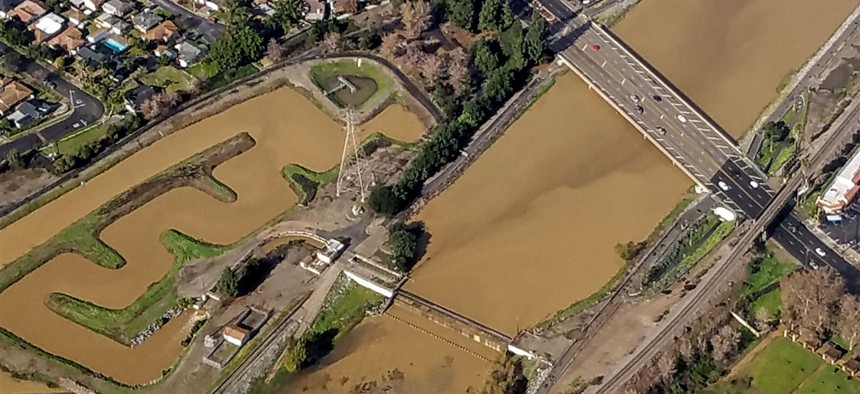As California’s Drought Eases, Should the State’s Conservation Mandates Be Rescinded?

Flying over the San Gabriel River in Pico Rivera, California, on Monday. Michael Grass / RouteFifty.com
As some call for continued vigilance, water officials in San Diego want the restrictions lifted.
LOS ANGELES — It’s been a sight for sore eyes across Southern California: Precipitation. And a lot of it.
Last weekend, the L.A. area saw its most significant rains in several years, flooding freeways and triggering mudslides in vulnerable locations. Long Beach Airport set an all-time rainfall record of nearly 4 inches.
As Route Fifty saw while flying into Los Angeles International Airport from the east on Monday, just as the last of the major rains were pushing out of the area, there was water aplenty.

Along the San Gabriel River, just east of L.A., water had inundated floodplains along its course, which has been mostly dry in recent years, like most rivers in Southern California. The concrete channel that holds the Los Angeles River, designed contain floodwaters, was filled with water draining out to the sea.

At long last, the Golden State’s multi-year drought has eased, or as is the case of most of Northern California, has completely disappeared. But Southern California can’t celebrate just yet.
While a new map from the U.S. Drought Monitor released Thursday confirms that no part of California is experiencing “Exceptional Drought” conditions—as had been the previously the case—portions of Kern, Los Angeles, Santa Barbara and Ventura counties still are experiencing “Extreme Drought” conditions, while “Severe Drought” is still the norm from San Diego into the San Joaquin Valley.
The Lake Cachuma reservoir in Santa Barbara County is only at 13 percent capacity, according to the Los Angeles Times.

Still, the improving drought conditions have prompted questions of whether the state should cancel its strict water conservation mandates. Water authorities in San Diego, who this week declared the drought over in their jurisdiction, want the state’s emergency water measures rescinded.
But that’s likely not going to happen in the immediate near term.
Earlier this month, as major storms refilled reservoirs across California, the staff of the State Water Resources Board has recommended that the strict cutbacks imposed in 2015 should continue until at least May once the winter rainy season concludes, The Mercury News reported. Members of the board will vote on how to proceed at a meeting scheduled for Feb. 7.
In a state that’s been devastated by drought, a return to water conservation apathy could come back to haunt Californians.
“It’s not likely that this month or next month we’ll erase the drought because our deficit is so large,” Alex Tardy, a National Weather Service meteorologist, told the Press-Enterprise on Monday regarding the situation in Southern California. “The one thing we have to keep in mind is that our deficits are still 20 to 24 inches of rain over the past six years.”
As The Sacramento Bee’s editorial board wrote on Thursday, “[i]n part because of climate change, in part because of greater demands on water, Californians must not go back to water-wasting ways.”
Michael Grass is Executive Editor of Government Executive’s Route Fifty and is based in Seattle.
NEXT STORY: Philadelphia Mayor Factchecks Trump’s Remarks on City’s Murder Rate






